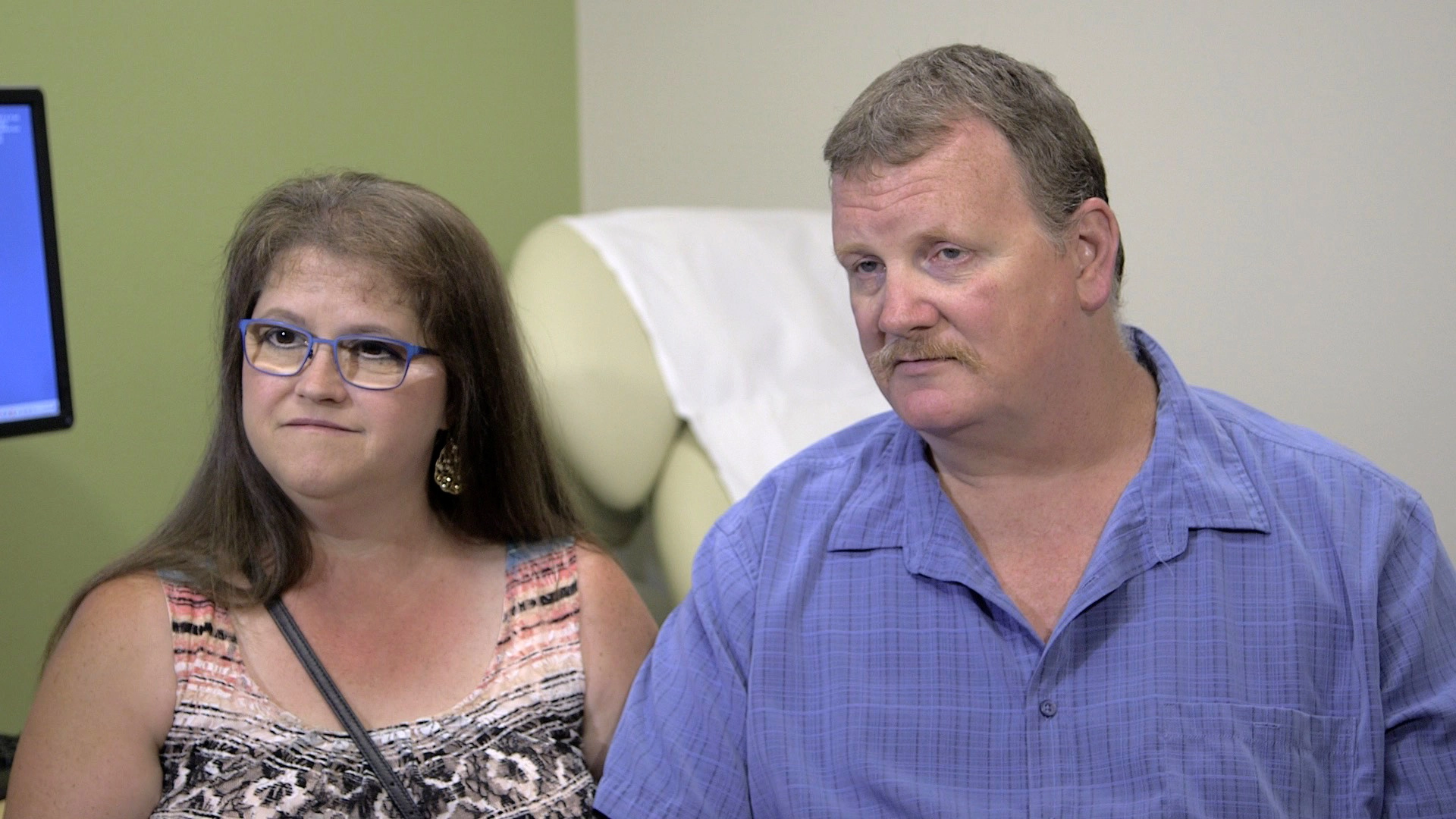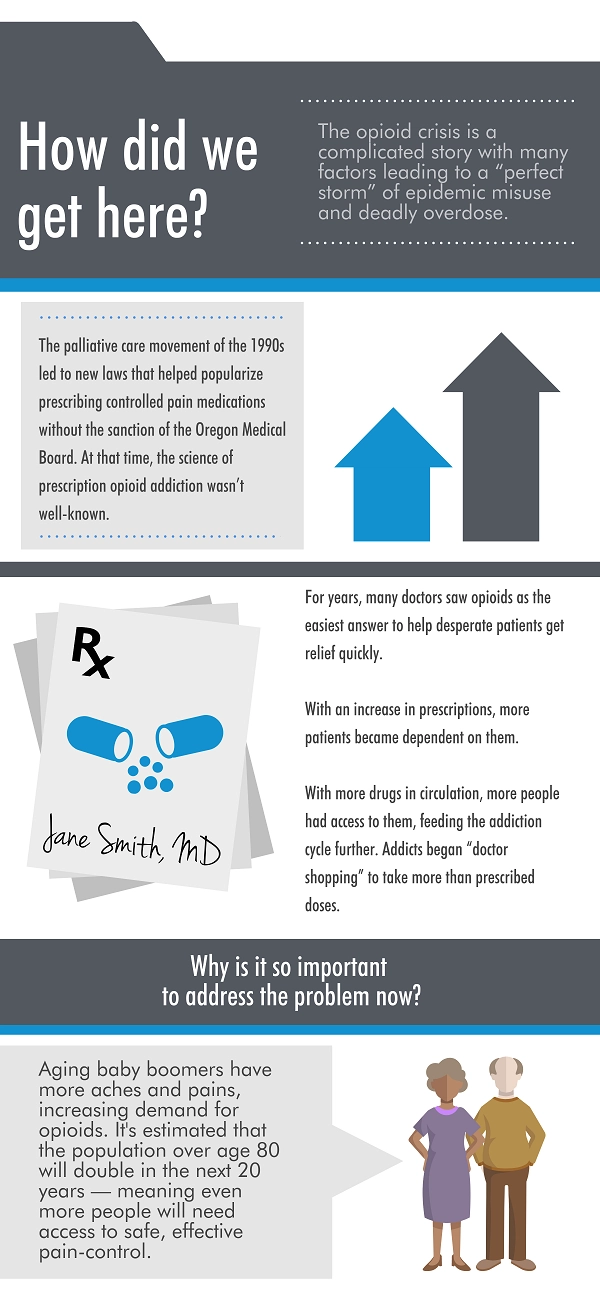New pain clinic helps patients kick opioid addiction

“Our goal is to reduce dependency through a holistic health approach.” – Paul Coelho, MD, Salem Health Pain Clinic director
Opioid addiction is in the news everywhere lately — from newspapers to social media to professional health journals. We don’t have to look very far to find the effects in our own town.
Just ask Ron and Tessie C.
“I wasn’t living, I was just fighting the pain,” Ron said, addressing a recent forum of 200 doctors and staff from the Salem Health Medical Group. “I literally thought I was going to die. Opioids are a one-way ticket to a place you don’t want to go.”
Ron’s odyssey began 20 years ago when he hoisted a 12-foot laminated plank caked with mud on a masonry job. His back popped. He started prescription pain medication, and a retraining program led to a computer tech job for almost nine years.
But then he had a heart attack at his desk. Between that and his progressively stronger prescriptions to cope with chronic pain, Dr. Ronald Palm from the Salem Health Medical Group had to put his foot down.
He knew his patient was getting addicted.
“Dr. Palm pleaded with me to trust him,” Ron said, referring to a visit he arranged with Dr. Paul Coelho, Salem Health Pain Clinic medical director.
The first appointment was a disaster.
“I fought them all, tooth and nail,” Ron said, “I wasn’t a drug addict!”
Ron was so angry at his first session he said he needed “intervention” to calm down. His second visit wasn’t much better. He laughs about it today, chiding Dr. Coelho for his grumpy bedside manner when confronting him about his, um, drug addiction.
“He’d already butted heads with the patient before me, so I guess it was my turn,” he laughed. “Thank God he did, because by my third visit, I started to listen. I owe my life to him. Those two doctors are like brothers to me now.”
Ron was diagnosed with “opioid use disorder,” a lifelong, relapsing disease – but it’s treatable with Suboxone. The clinic has successfully gotten Ron off his Oxycodone, replacing it with Suboxone, which interrupts the transfer of pain signals and reduces craving for riskier opioids.
“It allows him to live again,” said Dr. Coelho. “We continue to see and treat Ron and together are working toward improvement.”
Back to the living
Ron and Tessie were high school sweethearts. She’s helped him face the pain, literally. Today, they can enjoy travel, their kids and grandkids.
“I have an awesome life, wife and family,” Ron said. “I’m working to regain more function of my heart, which is at about 55 percent. Even if that’s all I get, I’ll still live longer. I don’t know what God has in store, but it’s not opioids.”
Where to turn when nothing works
If you have chronic or acute pain (unrelated to cancer), where do you go? If you have a primary care provider, ask for a referral to the new Salem Health Pain Clinic.
The clinic isn’t just for patients worried about opioids; it helps patients heal or handle any level of chronic pain. Staff work closely with patients’ primary care providers.

Why we care: A national epidemic
Oregon led the nation in nonmedical use of prescription opioids last year, according to a recent report by the Oregon Prescription Opioid Taskforce. For example, Oregon saw a five-fold increase in opioid-related deaths between 2000 and 2006. Nationwide, six out of 10 overdose deaths involve opioids and 91 Americans die every day.
Although that trend has stabilized, any death is one too many for Dr. Coelho, head of Salem Health Pain Clinic. Created last year, his clinic averages 240 patients a month by referral from other clinics, and is already recruiting for more certified pain specialists.
Having trouble getting in?
The biggest problem Dr. Coelho hears is that patients can’t get in anywhere.
“When we get a referral, patients will get in,” he said. “Our goal is to educate patients about the dangers of opioid misuse.”
The clinic follows a two-pronged approach: Following the Centers for Disease Control and Prevention Guideline to Prescribing Opioids for Chronic Pain, combined with a holistic approach to reduce dependency through all aspects of health — physical, social and mental.
“The biggest hurdle we help patients overcome is accepting they have a problem with pain medication,” Dr. Coelho said. “After all, nobody wants to be labeled a drug addict, especially if they’re using prescribed drugs.”
The truth about opioids
Opioids — such as hydrocodone and oxycodone — are beneficial when taken for fewer than three months, Coelho noted. Used long-term, however, studies show they don’t really improve function.
“It’s a vicious cycle because the brain likes the drug, so the body eventually tells the brain it wants more, just to feel normal,” Coelho said. “Our approach is to change the brain signals to change the pain cycle, similar to the classic 12-step recovery process.”
“It’s often more convenient for both patient and doctor to simply address the physical pain, which is more socially acceptable,” he said. “Nobody wants to be labeled a drug addict, especially if they’re using prescribed drugs!”
The clinic aims to help patients understand their pain, not feel stigmatized, and reduce their dependency by prescribing other medications and teaching other options.
“Opioids should be the last resort,” he said.
More resources
The Community Health Education Center often host classes that deal with treating and managing pain. Search for upcoming classes here.